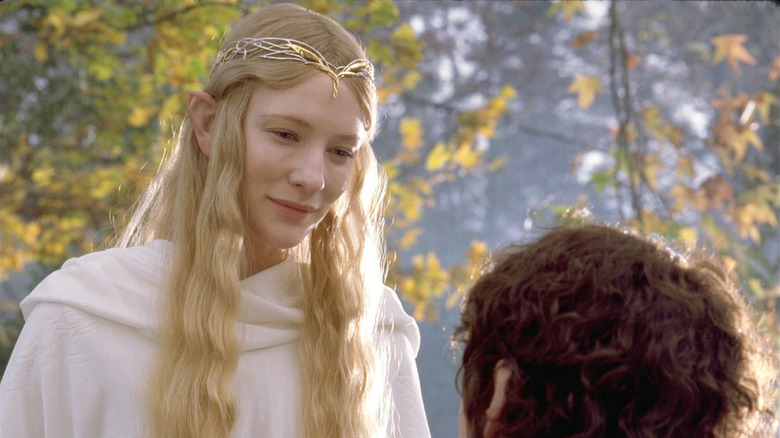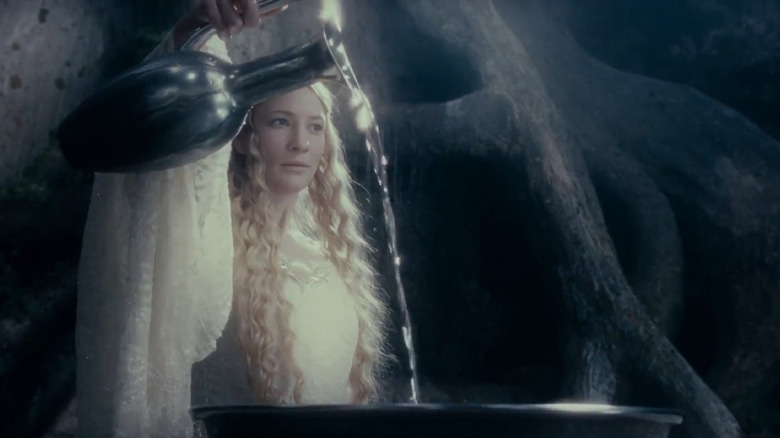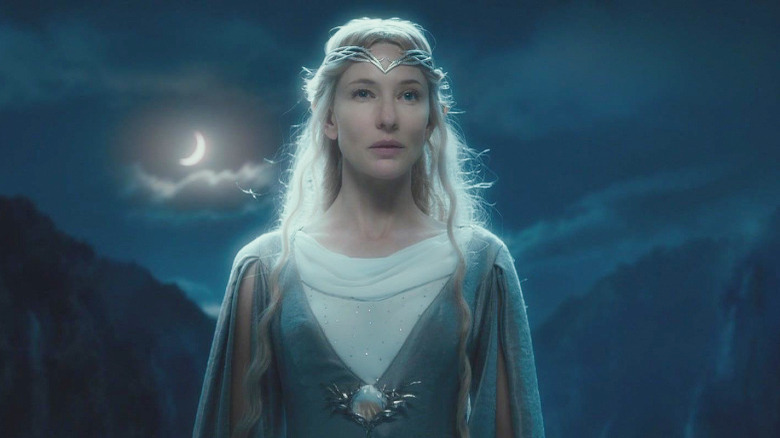One Of The Lord Of The Rings' Signature Special Effects Left An Impression On Cate Blanchett
History became legend. Legend became myth. And for two and a half thousand years (give or take 2,479 years), nerds like us refused to shut up about all the cinematic wizardry Peter Jackson and his production team employed to bring Middle-earth to life in their "The Lord of the Rings" film trilogy.
Two decades after Jackson's adaptation of J.R.R. Tolkien's fantasy tome took the world by storm, grossing billions of dollars at the box office and racking up well over a dozen Oscars for its efforts, "The Lord of the Rings" remains one of the all-time greatest feats of epic filmmaking. Naturally, its digital elements have come to show their age over the years, but in a way, that has only served to bring even more well-deserved attention to the many clever practical methods and in-camera tricks Jackson and his crew utilized to make the movies — not least of all, the ones that transformed their actors into hobbits and dwarves.
Be it the extensive behind-the-scenes features included with the "Lord of the Rings" movies on home media or the numerous articles online, one need not go far to find sources detailing the various ways these films use forced perspective and body doubles to make select members of its cast appear to tower over others. In her recent Hot Ones interview, the Lady Galadriel herself, Cate Blanchett, recalled how one particular item in Jackson's toolkit, the split diopter lens, "blew [her] mind the most when [she] saw it in action" on the movies' sets (as host Sean Evans put it).
You cannot hide. I see you!
The split diopter lens, for those who are not familiar, is a type of camera lens that allows select areas of a shot to remain in focus, as opposed to only having a single plane in focus (shallow depth of field) or having everything within the frame in focus (long depth of field). Because split diopter shots don't imitate the way we perceive the world with our naked eyes, they're a great way to make viewers feel uneasy or to visually signal that someone on-screen is not to be trusted. This is also why they're frequently used in horror films, be they classics like "Jaws" or more recent movies like Luca Guadagnino's "Suspiria."
Alternatively, a split diopter lens can make two actors seem physically closer to one another than they really are on-set, so as to better create the illusion that one of them is much bigger than the other (when, in reality, one of them is merely closer to the camera than the other). As Blanchett explained, Jackson would combine split diopter shots with other tricks to create an illusion of height disparity in scenes, like the one in "The Fellowship of the Ring" where Galadriel talks to Frodo (Elijah Wood) about his quest to destroy the One Ring:
"I think it was what Peter Jackson was calling – I'm sure they've been used a lot now – is a split-frame diopter. It's something they do with the lens so that you can hold two people of monumentally different sizes in the same frame, and that they would build a table where on one side everything was obviously – it was a bit like, you know, a piece of theater – is that everything was large on one side, and everything was small on the other side."
The Lord of the Rings vs. The Hobbit
As inventive as the "Lord of the Rings" films are in the ways they deceive viewers with this height disparity effect, it's admittedly far from a seamless trick and plainly sticks out once you know to look for it. What's more, Jackson and his fellow creatives would go on to refine and improve this special effect greatly years later in their "Hobbit" movies — arguably one of the rare areas where Jackson's use of high frame rate visuals readily benefitted those films aesthetically. All the same, Blanchett confessed to Evans that this is one case where she still has a soft spot for the more old-school techniques:
"But there was something to do with the lens where they were able to hold them, a bit like a kind of funhouse mirror, which was really incredible, because it was done in-camera, which was pretty cool. Because a lot of that stuff – and I think you can feel it when it's all done in [post-production], you know? I love it when those tricks are done in camera."
The visual effects artists on "The Lord of the Rings: The Rings of Power" have only further built on the foundation laid by Jackson's Middle-earth film trilogies, allowing "big folk" like The Stranger (Daniel Weyman) to seamlessly interact with his far smaller harfoot friends in the prequel series. But at the same time, like Blanchett said, it's hard not to look back fondly on this specific aspect of Jackson's "The Lord of the Rings," less convincing it may be.


